
by Kate S. Zalzal Thursday, April 6, 2017
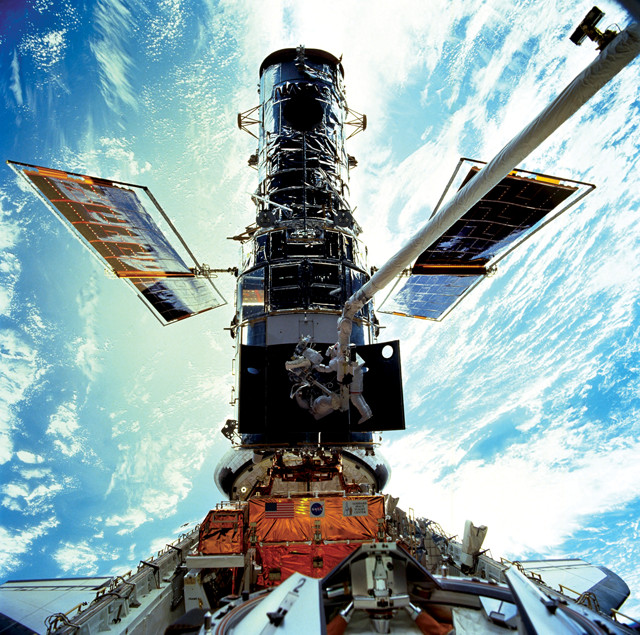
Astronauts Steven L. Smith and John M. Grunsfeld replace gyroscopes inside the Hubble Space Telescope during a December 1999 service mission. Credit: NASA/ESA.
Five hundred and eighty kilometers above Earth, orbiting at more than 27,000 kilometers per hour, is a 12-ton, bus-sized eye on the universe: the Hubble Space Telescope. When Hubble launched aboard the space shuttle Discovery on April 24, 1990, scientists hoped it would provide answers to many of the great unknown questions of the day. How old is the universe? How fast is it expanding? What lies between galaxies?
Since then, Hubble’s 2.4-meter mirror, cameras, spectrographs and sensors have peered into some of the deepest recesses of our universe, providing spectacular images of cosmic phenomena. These glimpses — snapshots of how the universe appeared as far back as 13.3 billion years ago — have revolutionized nearly every aspect of space science, fundamentally changing how we view the cosmos.
Hubble is one of NASA’s most successful and longest-lasting missions. A marvel of engineering and ambition, the solar-powered telescope has been serviced five times during its 27 years in orbit — updated with improved equipment and new instruments during bold and technically demanding space walks. It’s also one of history’s most important observatories. More than 10,000 scientific articles have been published using data from Hubble, and its images have been viewed around the world.
Named after American astronomer Edwin P. Hubble (1889–1953), who was the first to prove that the universe is expanding, the telescope offers such unique clarity because it orbits above the blurring effects of Earth’s turbulent atmosphere. Unlike ground-based telescopes, Hubble’s observing conditions never change. The telescope observes in visible light as well as wavelengths of near-infrared and ultraviolet light, allowing it to see distant objects that are often hidden within the dust of space.
By the time it launched in 1990, the concept of a space-based optical observatory had been in play for decades. Lyman Spitzer, a professor at Yale University, put forth the idea in 1946 and later headed the National Academy of Sciences committee that urged its development. Congress funded the project in 1977 after NASA involved the European Space Agency.
After technical difficulties postponed the original plans to launch the telescope in 1983, Hubble’s launch was again delayed in the wake of the 1986 Challenger disaster. Shuttle flights resumed in 1988, and two years later Hubble was ready to launch.
Even then, things didn’t go smoothly for Hubble. Almost immediately, scientists noticed that the images sent back were slightly blurred. A minuscule defect in the shape of Hubble’s mirror — about one-fiftieth the thickness of a sheet of paper — was to blame. Starlight could not be brought to a sharp focus. But by 1993, in time for Hubble’s first scheduled service mission, scientists had developed a fix. In the most complex space mission ever attempted at the time, involving five days of space walks, astronauts successfully installed corrective optics on Hubble. Astronomers could now take full advantage of the space telescope’s capabilities.
Hubble’s final scheduled service mission was in 2009. Despite remaining in good working order, the telescope is now set to fade into retirement. Its cosmic successor, the James Webb Space Telescope (JWST), is scheduled to launch in 2018. The JWST is not a direct replacement for Hubble. Primarily an infrared instrument, it will orbit much higher (1.5 million kilometers above Earth and beyond Earth’s moon) and is designed to see better through dust and to look back at the earliest birth and evolution of galaxies in the wake of the Big Bang.
As Hubble enters into what are likely to be the final years of its mission, here are some of the astronomical phenomena it has helped us explore.
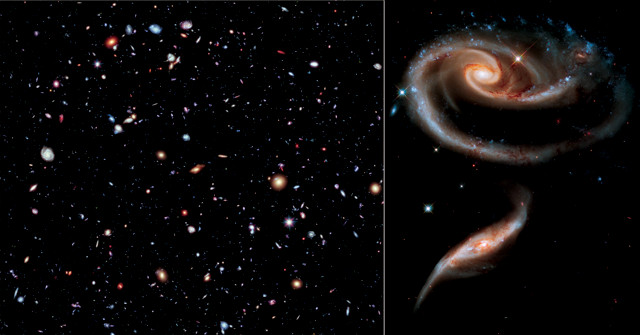
The Hubble deep field surveys reveal the infant universe and capture galaxies at different stages of their evolution, showing how galaxies interact, merge and evolve. Credit: left: NASA, ESA, G. Illingworth, D. Magee, and P. Oesch (University of California, Santa Cruz), R. Bouwens (Leiden University), and the HUDF09 Team; right: NASA, ESA and the Hubble Heritage Team (STScI/AURA).
Hubble images have led to estimates that the known universe contains between 200 billion and 2 trillion galaxies, and that each of these contains tens to hundreds of billions of stars.
In 2003–2004, using the “deep field” camera, scientists positioned Hubble to peer into a patch of empty-looking sky, soaking up all the light it could during 400 Earth orbits. That tiny patch of sky, in the constellation Fornax, represents just one thirteen-millionth of the total area of sky, but within it lies an estimated 10,000 galaxies as seen in the Hubble “Ultra Deep Field” image. NASA released further refined versions of the image in 2012 and 2014 (the “eXtreme Deep Field” image) that reveal even more galaxies, some that existed 13.2 billion years ago when the universe was only 450 million years old.
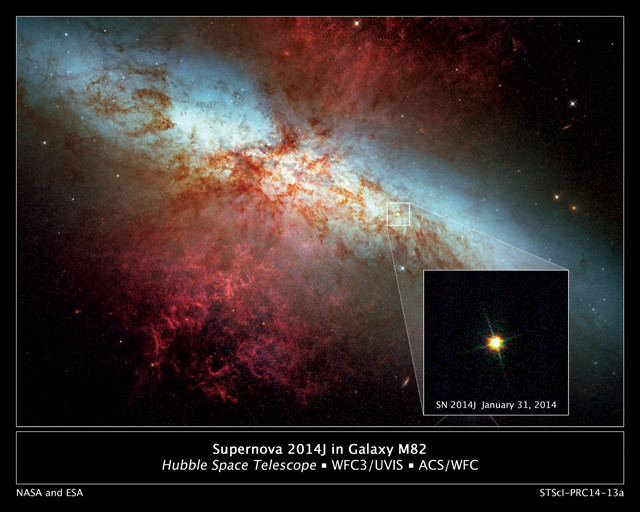
This composite image from Hubble captures a supernova explosion (observed in 2014) in the galaxy M82, approximately 11.5 million light-years from Earth. Credit: NASA, ESA, A. Goobar (Stockholm University), and the Hubble Heritage Team (STScI/AURA).
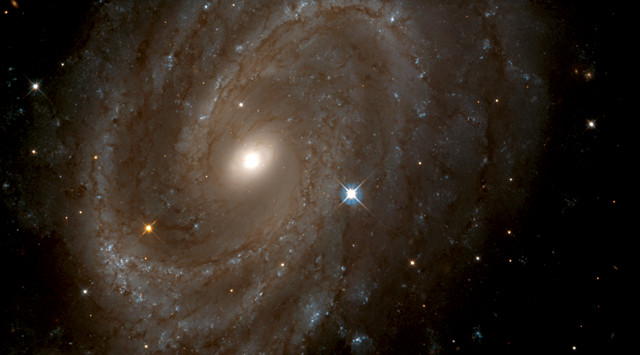
Scientists measured Cepheid stars to determine the distance to the spiral galaxy NGC 4603, seen here. Credit: Jeffrey Newman (University of California at Berkeley) and NASA.
Prior to Hubble, scientists had estimated the age of the universe to be between 10 billion and 20 billion years. To refine this range, researchers used pulsating Cepheid variable stars located at great distances across the universe like cosmic yardsticks. With precise measurements of galaxy distances, scientists calculated the universe’s expansion rate, which yielded an age of 13.7 billion years for the universe.
Since the confirmation of the Big Bang theory in the 1960s, it had been assumed that gravity was decelerating the universe’s expansion rate. But Hubble’s observation of distant supernovae — the explosions of massive stars that are bright for only a short period of time — along with ground-based telescope data, showed this is not true. The supernovae were dimmer than expected, meaning that they were farther away than they would be if the expansion rate were truly decelerating. Scientists have since determined that the expansion rate is actually accelerating, driven by a mysterious force called “dark energy” that appears to pervade the cosmos. The expansion rate has been calculated to be 73.2 kilometers per second per megaparsec — meaning that for every million parsecs (one parsec equals about 3.3 light-years) of distance from the observer, the expansion rate increases by 73.2 kilometers per second.
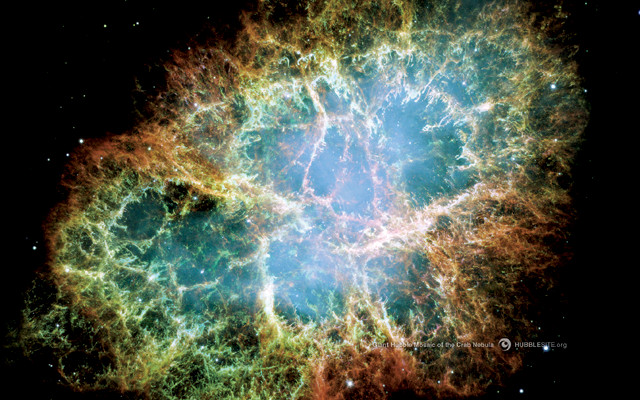
This image of the Crab Nebula, compiled from images taken in 1999 and 2000, shows the expanding remnant of a supernova about six light-years wide. The colors in the image indicate different elements expelled during the explosion. The light burst from this violent event was seen and recorded in 1054 by Japanese and Chinese astronomers. Credit: NASA, ESA, J. Hester and A. Loll (Arizona State University).
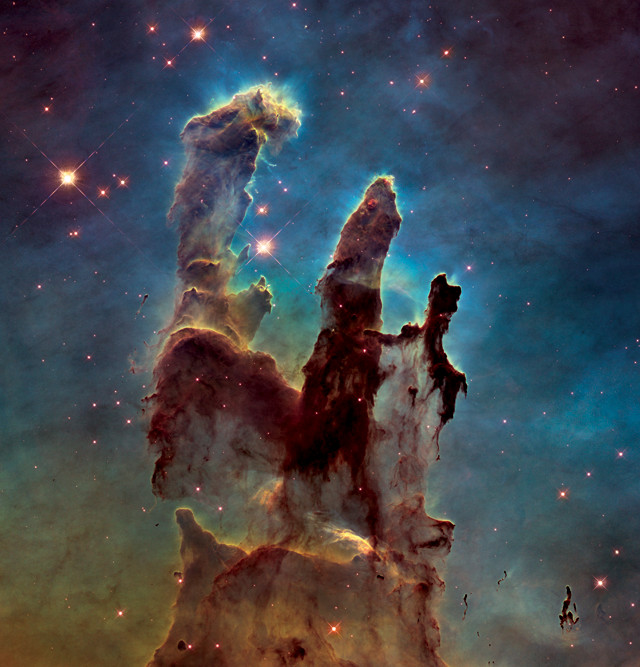
The famous Pillars of Creation image, taken in visible light, shows gas clouds and cosmic dust in the process of creating new stars within the Eagle Nebula, 7,000 light-years away. Credit: NASA, ESA and the Hubble Heritage Team (STScI/AURA).
Nebulae are interstellar clouds of dust and gas. Often regions of star-formation or the remnants of dead and dying stars, nebulae can take on different sizes, shapes and characteristics. Hubble imagery has helped scientists better classify and characterize these vast astronomical structures.
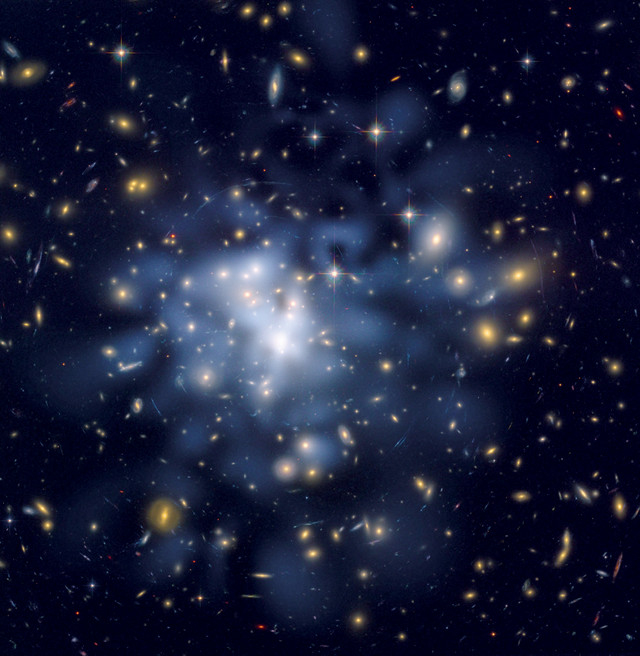
This image shows the dark matter distribution (dark matter is shown as bluish-white clouds) in Abell 1689, a giant galaxy cluster that is 2.2 billion light-years away and contains about 1,000 galaxies and trillions of stars. Credit: NASA, ESA, D. Coe (NASA Jet Propulsion Laboratory/California Institute of Technology, and Space Telescope Science Institute), N. Benitez (Institute of Astrophysics of Andalusia, Spain), T. Broadhurst (University of the Basque Country, Spain), and H. Ford (Johns Hopkins University).
The portion of the universe we can see is only a small fraction of the entire universe. Dark matter makes up about 27 percent of the matter in the universe, but is detectable only by its gravitational pull on the visible matter around it. Dark matter bends and amplifies visible light from distant galaxies in an effect called gravitational lensing, which Hubble can detect. Dark matter mapping may also help scientists better understand the nature of dark energy and its role in the early universe.
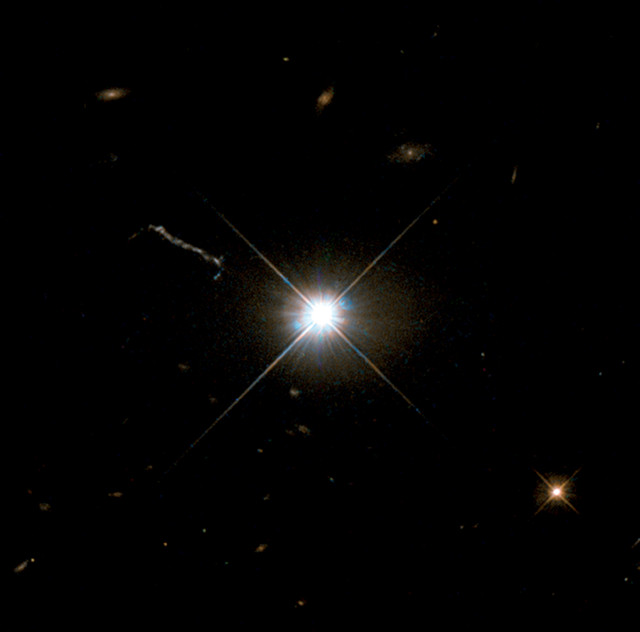
As material falls inward, toward the black hole, some quasars, including this one called 3C 273 located in a giant elliptical galaxy some 2.5 billion light-years away, have been observed to fire off super-fast jets that appear as cloudy streaks. Credit: ESA/Hubble and NASA.
Hubble imagery has shown that black holes — gravitationally collapsed stars so dense that they prevent light from escaping — are common at the center of most galaxies. Hubble has also furthered the understanding that galaxy evolution is linked to black hole growth and that black holes are the gravitational engine for a variety of bizarre phenomena, including quasars. Quasars, the incredibly bright centers of distant galaxies, are the brightest-known objects in the universe. Galaxy collisions and mergers may help feed black holes, further energizing the quasar.
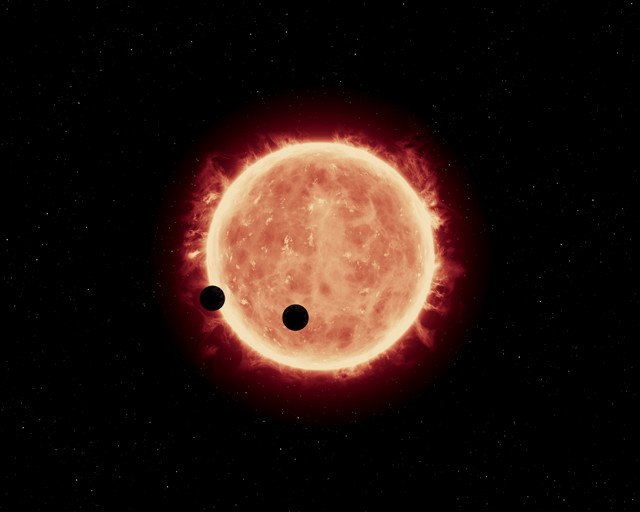
In a 2016 survey, Hubble analyzed the atmospheres of two exoplanets approximately 40 light-years away and seen here in an artist's interpretation. Scientists determined that the exoplanets are unlikely to have life-smothering hydrogen-dominated atmospheres, leaving open the possibility that they are habitable. Credit: NASA, ESA, and G. Bacon (STScI).
Since the first observation in 1995 of a planet orbiting another star, there has been an explosion in exoplanet discoveries. Hubble captured the first visible-light image of a gas-giant planet orbiting the star Fomalhaut in images taken in 2004 and 2006 and made the first measurements of the atmospheric composition of an exoplanet by spectroscopically measuring the parent star’s light as it filtered through the exoplanet’s atmosphere. While Hubble remains in orbit, it will continue to explore exoplanets around the 1,000 red-dwarf stars known to be close to Earth.
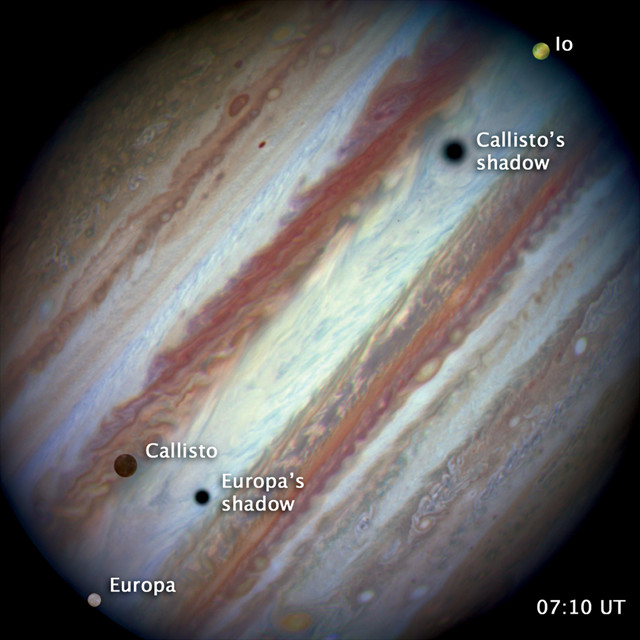
In January 2015, Hubble took a sequence of photographs capturing three of Jupiter's largest moons, Europa, Callisto and Io, zipping across its banded face at the same time. This event occurs only once or twice a decade. Credit: NASA, ESA, and the Hubble Heritage Team (STScI/AURA).
Hubble has led to numerous discoveries within our own solar system. In addition to capturing spectacularly detailed images of our neighboring planets, the telescope has also confirmed the existence of a fifth moon orbiting Pluto, provided a close-up look at comet disintegration, shown evidence of a new dark vortex in Neptune’s atmosphere, and captured images of possible water plumes erupting from Jupiter’s moon Europa.
© 2008-2021. All rights reserved. Any copying, redistribution or retransmission of any of the contents of this service without the expressed written permission of the American Geosciences Institute is expressly prohibited. Click here for all copyright requests.